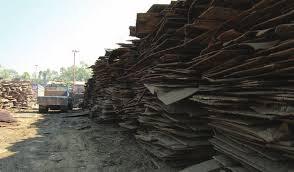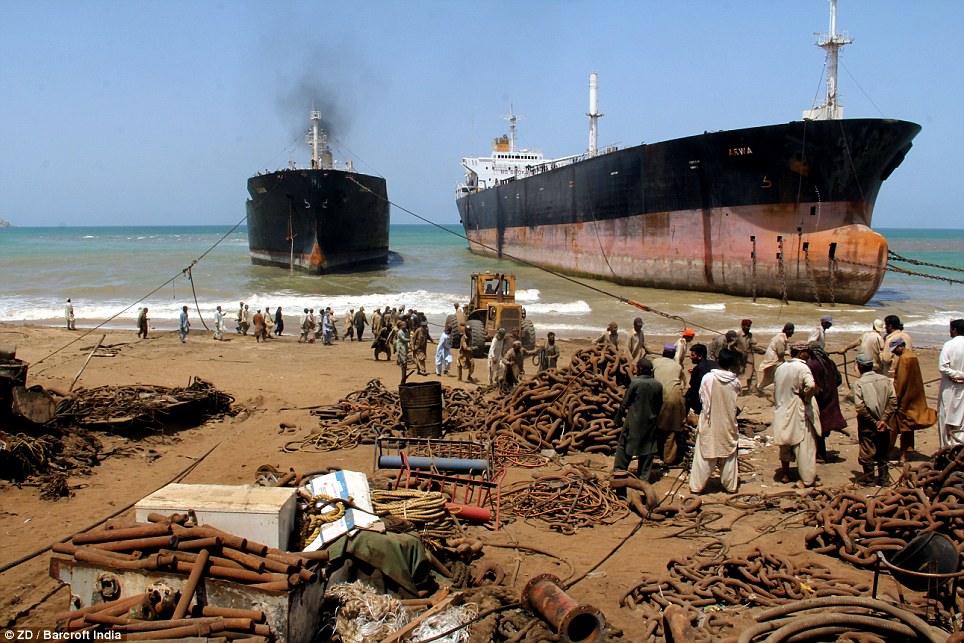How do you make a 10,000-tonne container ship disappear? At Alang, a small town in Gujarat, on the western coast of India is the world’s biggest ship-breaking town. Almost a third of all retired vessels—at least 200 each year—are sent to be broken up here, at over 100 different yards stretching along 10km of sand. The industry employs some 20,000 people, almost all men who migrate from the poorer states of India’s northern Hindi-speaking belt. Taxes paid by breakers generate huge sums for the state government. Yet it is a dangerous industry for its workers and a filthy one in environmental terms.
Of 744 ships that were pulled apart worldwide last year, 518 were dismantled on beaches. Only 226 were processed “off the beach” at industrial sites designed for the purpose, according to the Shipbreaking Platform, an ngo which campaigns against beach-breaking. The majority of big shipping firms use beaches, except a tiny few such as Hapag Lloyd of Germany and Boskalis of the Netherlands.
A typical operation involves a ship being beached at low tide. Once her fittings and other resaleable parts are removed, hundreds of workers with gas blowtorches clamber over the vessel’s hull, cutting it into huge steel blocks. These are then dropped onto the beach, where they are cut up again before being sold, then rerolled for use in construction.
Apart from the danger of dropping tens of tonnes of steel from a great height, the method is immensely polluting. A review in 2015 by Litehauz, a Danish marine environmental consultancy, found that in the process of scrapping a 10,000-tonne ship at least 120 tonnes of steel becomes molten and is lost in the sea. Levels of mercury and lead, as well as oil, in Alang’s water are at least 100 times higher than at other beaches. Workers must handle asbestos and dangerous chemicals. Accidents are common. Last year 14 workers died at Alang.Alang is just one of many ship-breaking centres in South Asia. Among the others are beaches in Bangladesh (where workers reportedly include children) and Pakistan. Last year the subcontinent recycled around 90% of the world’s ships by tonnage.
Ship-breaking is concentrated in the region for three reasons. Prices for scrap steel are higher than elsewhere (90% of a ship is typically steel), thanks to demand for rerolled steel for construction. Labour costs are lower than at yards in Europe, America or Turkey (workers at Alang make up to 800 rupees, or $11, per day, and usually less) and safety and environmental regulations are much weaker. Most sellers scrap their ships in South Asia because they get better prices for them.
Shipowners, in particular Maersk, a Danish company which is the world’s biggest shipper, are preparing to comply with them…At the Baijnath Melaram shipyard a huge crane barge sits in the water next to a stretch of “impermeable” concrete. “We used to have to winch the blocks up the beach,” says Siddharth Jain, the firm’s business manager. Now, the crane lifts blocks of steel down from the ships directly to the concrete, so that they need never touch the sand. In contrast to the yards nearby, where men in simple work clothes and no safety goggles operate blowtorches, the workers scuttling around Baijnath Melaram wear boiler suits, face masks and helmets.

The changes are largely down to Maersk… Around 70 more are upgrading in order to meet standards set by the Hong Kong International Convention for the Safe and Environmentally Sound Recycling of Ships, an unratified treaty on ship recycling. Maersk’s campaign is in response to new regulations in force since December 31st 2018 that require all European-flagged vessels to be recycled at shipyards approved by Brussels. Just over a third of the world’s ships fall in this category. Maersk, whose fleet is roughly 40% European-flagged, hopes that the best yards at Alang will be able to comply with the new rules. Two Indian yards have already been audited for the European certification; 11 more have applied. “If we sustain that momentum, in five, six or seven years all of Alang could be really responsible,” says John Kornerup Bang, Maersk’s sustainability chief.
But on January 30, 2019 the eu announced that the Indian yards audited will not make the list,… Ingvild Jenssen of the Shipbreaking Platform says that even Alang’s best yards are not clean enough. She argues that Maersk’s efforts merely “greenwash” a model that needs to change completely…. Not clean enough for Europe; but too expensive to compete with breakers in Bangladesh or Pakistan which have not changed at all. If that happens, the industry in Alang—and the jobs and revenue it generates—could disappear almost as quickly as the ships it dismantles.

Excerpt from HIgh by the Beach: Ship Recycling, Economist, Mar. 9, 2019

